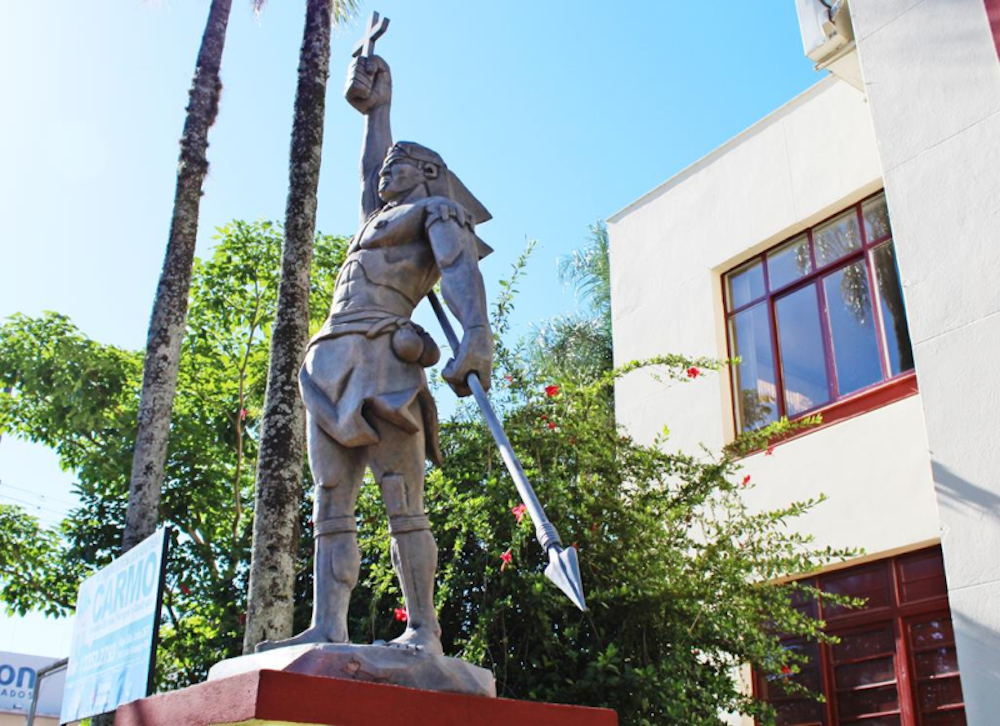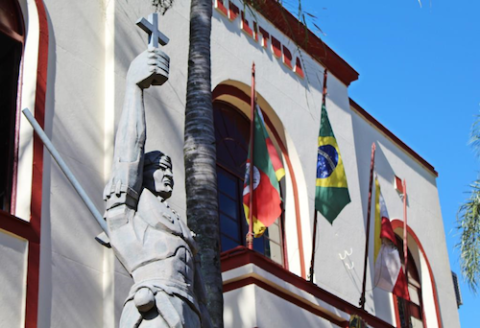
Statue of Sepé Tiaraju (Courtesy of the Prefecture de São Luiz Gonzaga)
The possible canonization of an 18th-century indigenous leader from the south of Brazil may lack much significance for his own people, distanced as they currently are from Catholicism. But the organizers of the campaign for the recognition of Sepé Tiaraju's sainthood believe it will certainly reposition his figure — to a great extent appropriated and decontextualized by his executioners — as a true Catholic martyr and a symbol in the struggle for justice and sovereignty.
The idea of canonizing Sepé Tiaraju, who was killed while defending the Jesuit missions where thousands of his fellow Guarani lived, emerged in the 1970s, although he had enjoyed the status of a regional popular saint since his death. At that time, popular Catholic movements in the Southern State of Rio Grande do Sul started to reflect on his history and legacy for Catholics and for the Brazilian people as a whole.
"We organized a first procession in honor of martyrs as Sepé Tiaraju 43 years ago. It occurred on Feb. 7, the day of his death, close to the area where the massacre occurred," explained Fr. Alex Kloppenburg, one of the enthusiasts of the idea.
Kloppenburg is a diocesan priest in Santana do Livramento and a longtime advisor to the movement of basic ecclesial communities in Rio Grande do Sul State, which were particularly strong in the 1970s and 80s.
Advertisement
Other processions and pilgrimages in Tiaraju's honor became annual, always boosted by groups of peasants and poor workers. "We feel inspired with Sepé Tiaraju's example of evangelical virtue and his defense of community values," Kloppenburg told NCR.
After some time, the group led by the now-deceased Marist brother Antonio Cechin decided it was time to formally require the opening of a process of canonization. In 2017, the idea was taken to the Vatican, which approved the evolution of the case.
"We've already composed a prayer that was approved by the bishop of the Diocese of Bagé, and we're working to disseminate the campaign," Kloppenburg said. "It's a long process. At this point, we're spreading his name and talking about his legacy," he added.
Sepé Tiaraju's history is deeply connected to the history of the Jesuit Guarani missions in South America, initiated in the 17th century. The missions — also known as reductions — were not only a colonial project conceived by the European missionaries as a way to convert great masses of indigenous peoples, but also a strategy of protection on the border of the Spanish and Portuguese colonies.
"The missions were created as an intermediary place. The Spanish subjected the indigenous peoples to compulsory work at the encomiendas. The Portuguese used to capture them and sell them as slaves in Brazil. The Guarani chiefs realized they could settle at a neutral space and avoid slavery," explained Jesuit Fr. Pedro Ignácio Schmitz, a professor at Unisinos, the University of the Valley of the Sinos (Bells) River, in Brazil.
The Jesuit priests managed to obtain an official permission from the Spanish empire to guarantee the indigenous peoples' freedom; at the reductions, they could live from their work without having to serve the Spanish colonialists. "That was a new space that had been formed," Schmitz said.
The missions included vast farmlands where the Guarani produced food for their own consumption — and they usually sold the surplus. They also had workshops and manufacturing centers where the Guarani produced clothes, tools, household items, and even sculptures and musical instruments. The missions were coordinated by priests but had a council elected by the community.
Such a project — defined by some as a kind of "republic" — enraged the colonialists from both sides. The material and social success that the reductions achieved over the years also drew the attention of the Paulistas, explorers and fortune hunters from the city of São Paulo, in the southeast part of Brazil.
"The Brazilian northeastern colonies had been occupied by the Dutch, who forbade the African slave trade throughout their territory. The Paulistas tried to provide slaves to the market by capturing the Guarani at the reductions," Schmitz said.

Ruins of the São Miguel Mission (Courtesy of the municipal office of São Miguel)
After repeated raids carried out by Paulistas, the Jesuit missionaries finally decided to move the reductions south. That's the region where the mission of São Luís Gonzaga was located, in which Sepé Tiaraju was born around 1723. He was a third-generation Catholic who had lost his parents at an early age and was raised at a cotiguaçu, a common house where widows and orphans lived.
"He was educated by the priests in their community Christian model and learned to read and write in Guarani, Spanish and Latin," Kloppenburg explained. When he was a young adult, Tiaraju was elected as chief of the council of São Miguel, which was something similar to a mayor.
In 1750, Portugal and Spain signed the Treaty of Madrid, by which the Portuguese Colonia del Sacramento, located by the La Plata River (currently in Uruguay), would be exchanged for the territory of the missions. It was dictated that all Guarani should leave the area of reductions, now under Portuguese control, and move to the west side of the Uruguay River, which were Spanish lands.
"They didn't want to leave their lands behind nor did the Jesuits, who knew that it would represent the end of the missions. So Sepé Tiaraju started to coordinate a resistance movement against the decision," said Kloppenburg.
Tiaraju and other leaders sent letters to the governor of Buenos Aires, who represented the Spanish crown, appealing to their common Christianity. But it was all in vain. "After all peaceful means had been exhausted, Tiaraju and his fellow Guarani decided to wage war on the Europeans," Kloppenburg continued.
It's from that phase came the famous cry attributed to Tiaraju: "This land has an owner!" The phrase would be assumed as a slogan of sovereignty and autonomy by the inhabitants of the State of Rio Grande do Sul, known as gaúchos.

Statue of Sepé Tiaraju (Courtesy of the Prefecture de São Luiz Gonzaga)
Sepé Tiaraju was killed on Feb. 7, 1756. He was carrying in his pocket a prayer book and a letter in which he stated that God gave those lands to the Guarani. Only three days later, 1,500 Guarani were massacred in battle. "He died struggling for justice, for the right of his people to live, for his faith," Kloppenburg argued.
In 1767, the Jesuits were expelled from Spain and its colonies and the missions were assumed by other congregations. "But they didn't know how to work in that model, and the reductions soon decayed. The people from the missions became an uprooted people, wandering around the region and working at local farms," said Schmitz.
Today, there are about 80,000 Guarani in Brazil, distributed in three different groups, and dozens of thousands more in Paraguay, Argentina and Bolivia. In Southern Brazil, they live in very precarious conditions, given that the federal government has never granted land reservations to them.
"It's a very difficult reality. There's no perspective of future for them in such lands, considering their way of living," said Roberto Liebgott, a regional coordinator of the Indigenous Missionary Council (a Brazilian bishops' conference commission which assists indigenous peoples).
According to Schmitz, the Guarani groups that exist today are mostly descendants of peoples who were not part of the missions. Nevertheless, Sepé Tiaraju is a central historical figure for them, Liebgott pointed out.
"Tiaraju has an important presence in their cosmology as someone who was fundamental in the Guarani struggles. Every year they gather in February and remember his life," he told NCR.
Liebgott explained that the Southern Guarani people, known as mbya, in general are not Christian and resist the presence of missionaries. "But many Guarani mbya leaders I know approved the idea of Tiaraju's canonization. They know that several Catholic saints were martyrs as Tiaraju and understand that the church wants to reaffirm his relevance as a person who strived for life and for lands for everyone," Liebgott said.
In the opinion of Rodrigo Mariano, a Guarani lawyer from the State of Rio Grande do Sul, his people doesn't consider Tiaraju to be a saint, but are " happy about the recognition and the reference that's being made to them."
"He was a warrior, and like many other 'Sepés' he fought for our rights. From a historical point of view, this process is important for us," he told NCR.
Kloppenburg argued that the canonization of Sepé Tiaraju would be, among other things, a form of acknowledging the martyrdom of so many native people in the Americas. "It's also a celebration of numerous missionaries who struggled against the enslavement of indigenous peoples," he declared.

Ruins of the São Miguel Mission (Courtesy of the Palácio Piratini)
[Eduardo Campos Lima is a Brazilian journalist.]





